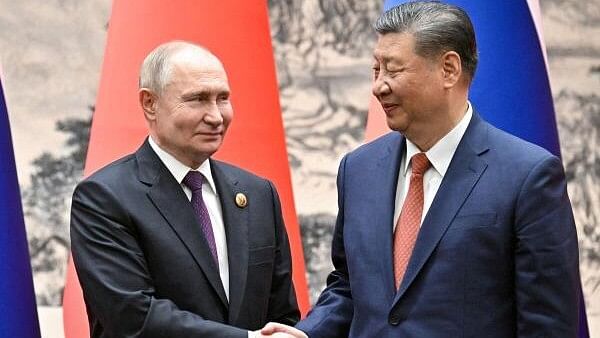
Russian President Vladimir Putin visits China.
Credit: Reuters Photo
The year 2024 marks the 75th anniversary of diplomatic relations between Russia and China, and Russian President Vladimir Putin’s two-day State visit to China, on May 16 and 17, was also his 63rd meeting with his counterpart Xi Jinping in bilateral and multilateral settings in the last decade. This underscores the comfort level the two leaders have with each other.
Apart from Putin’s formal meetings with the Chinese leadership, he also had a ‘restrictive meeting’ with Xi at Zhongnanhai, the nerve centre of China’s Communist Party leadership. By hosting Putin at Zhongnanhai, China’s message to the United States and European powers is that Russia is China’s most trusted partner, symbolically ranking first in the hierarchy of relationships. A similar status had been granted to the US in the post-1970 rapprochement.
Xi underlined the strong China-Russia relationship by using a Chinese adage, ‘a mountain is formed by the accumulation of soil and an ocean is formed by the accumulation of water’. This is a continuation of the declaration of partnership ‘without limits’ in early February 2022, just before Russia’s Ukraine invasion, later underscored by foreign minister Wang Yi, describing Russia as China’s most important strategic partner, and that the friendship between the two was ‘ironclad’.
Official statements after the meetings harped on the oft-repeated narrative of geopolitical shifts and the emerging multipolar world order.
The joint statement underlined a greater alignment between the two sides on a range of issues including reforming global governance institutions and the depoliticisation of the United Nations. It singled out ‘long-arm jurisdiction’, the alleged interference by the US and its allies in the name of democracy, and conveyed that there are multiple developmental paths for countries — the core idea behind the Global Security Initiative (GSI) and Global Development Initiative (GDI). It further identified the alliances in Indo-Pacific as a destabilising force, and called out the US for its hegemonic behaviour. That Russia agreed with these issues — and supported the narratives promoted by China — hints at Moscow reciprocating Beijing’s support for the Ukraine invasion.
The emphasis on co-operation in the Arctic and the rule-making for outer space militarisation further underlines the convergence of interests and reciprocity in their relationship.
The visit was keenly watched for whether and how China would push Russia to settle the Ukraine issue. By agreeing to China's language and tone of the GSI, Russia has supported the Chinese narrative on Ukraine and broader issues. In turn, China reiterated its peace plan to resolve the Ukraine issue, outlined in early 2023, which is unlikely to take off. Even if it does, it can still be considered a win-win for Russia.
European leaders who expected China to push Putin on Ukraine will be disappointed. By including the Harbin Institute of Technology — a banned entity by the US for alleged links to the People’s Liberation Army (PLA) — in the itinerary of the visit, China was clearly defying the US and its allies.
On the economic front, Russia and China are seeking to work on continuing co-operation in multiple arenas. The northeast Asian regional integration, which has been a long time in the making, was on the agenda. Putin’s visit to Harbin in the Heilongjiang province that borders Russia signals these priorities.
Questions, however, remain on economic ties. The visit did not signal any step forward on the Siberia-2 gas pipeline, which, if completed, will help Russian fuel supplies to China as an alternative to the European countries. Possibly, the irritants on the issue have been left to be resolved through hard negotiations later to prevent any impact on the optics of this visit.
This State visit projected Russia-China ties as an important pillar in the global arena and that it is resilient in the face of US-led pressure on both nations. The meeting also allowed both leaders to apprise each other of the ground situation in Ukraine, and share each other's perspectives.
Implications for India
Russia’s growing closeness to China over the last few years has been a cause for worry in New Delhi. India would view this meeting with great caution, considering its close military and defence ties with Russia, and the continuing stand-off with China at the Line of Actual Control in Ladakh.
Russia has often acted as the bridge between India and China in some important fora — like the Shanghai Cooperation Organisation (SCO), BRICS, and the Russia-India-China trilateral — cushioning the tenuous ties. Even as India began developing its strategic relationship with the US, ties with Russia continued under New Delhi’s multi-alignment/strategic autonomy framework. However, New Delhi should be closely watching China’s and Russia’s resolve to work in multilateral fora like the expanded BRICS.
Putin’s visit highlighted Russia’s increasing dependence on China for diplomatic, military, and economic support as a junior partner. As of now, India does not seem to be prepared for this inconvenient truth. What might add to India’s discomfiture is that the joint statement mentioned greater co-operation in outer space rule-making and industrial manufacturing. In the long term, this has implications for India’s outer space ambitions, and its dependence on military hardware from Russia. It will be interesting to see how India and Russia use their bilateral channels to come to terms with the China-centric narrative emerging from the Putin-Xi meeting.
(Devendra Kumar is an Associate Fellow at the Centre of Excellence for Himalayan Studies, Shiv Nadar Institution of Eminence. Anand P Krishnan is a Fellow at the Centre of Excellence for Himalayan Studies, Shiv Nadar Institution of Eminence, and an Adjunct Fellow, at the Institute of Chinese Studies.)
Disclaimer: The views expressed above are the author's own. They do not necessarily reflect the views of DH.